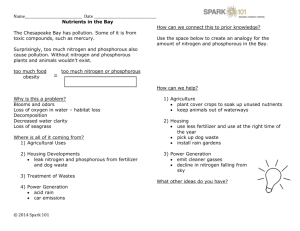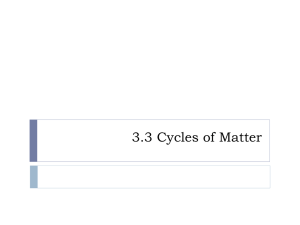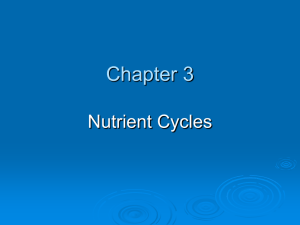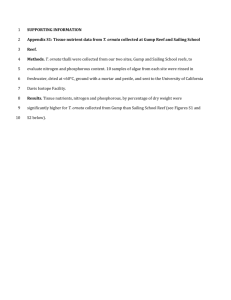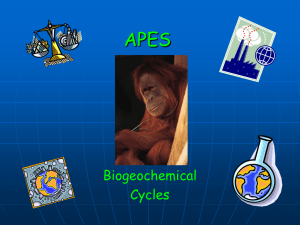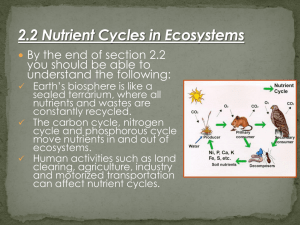Nutrient Circulation
advertisement
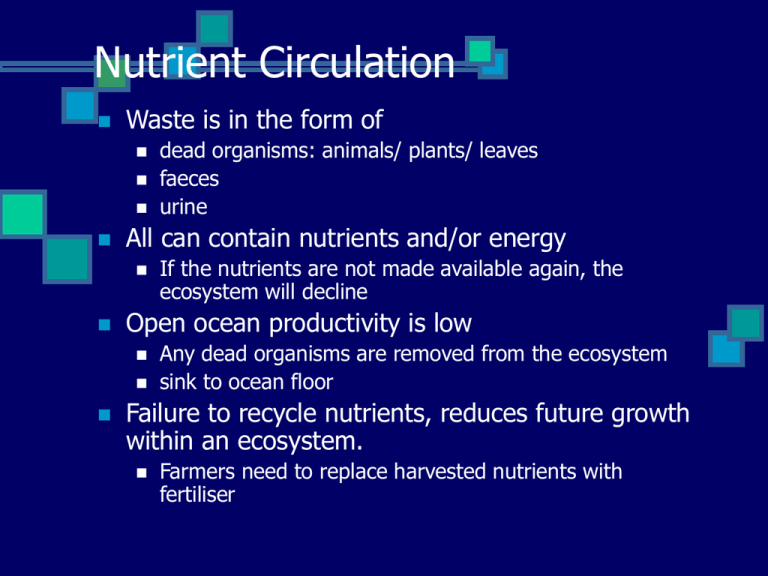
Nutrient Circulation Waste is in the form of All can contain nutrients and/or energy If the nutrients are not made available again, the ecosystem will decline Open ocean productivity is low dead organisms: animals/ plants/ leaves faeces urine Any dead organisms are removed from the ecosystem sink to ocean floor Failure to recycle nutrients, reduces future growth within an ecosystem. Farmers need to replace harvested nutrients with fertiliser Nutrient Circulation During degradation wastes are decomposed to release inorganic ions This is called - Mineralisation Can be absorbed by plants and used for growth Circulation depends on activities of 2 groups Detritivores Decomposers Detritivores Detritivores = detritus eating invertebrates e.g Earthworms, woodlice Turn large pieces of organic waste into small pieces (gain energy & nutrients for growth in doing so) Make humus (important soil constituent –for aeration, water retention/ drainage) Because they in turn enter food chains by being eaten by other animals (e.g birds), they recycle the nutrients (and energy) back into the ecosystem. Also increase the surface area of the detritus, so that decomposers can act more quickly Decomposers These are bacteria and fungi Saprophytic (obtain nutrients and energy directly from dead or decaying matter) A range of microbes found within soil Can secrete enzymes which degrade molecules e.g cellulase External digestion, forming a soluble soup easily absorbed Vital in e.g Nitrogen cycle, carbon cycle Decomposers live freely in soil or can be found in detritivore digestive tracts Rate of Decomposition Type of detritus (coniferous litter is slower than deciduous) Type and abundance of decomposers Abiotic factors temperature moisture (humus) aeration (humus) nutrient availability (nitrogen) Nutrient Cycling Animals gain nutrients from food Plants/ microbes gain nutrients from soil Macronutrients required in large amounts e.g N, P, S Micronutrients birds, some animals go to salt licks required in smaller amounts e.g Se, Mo, Mn All nutrients need to be soluble before they can be absorbed Lack of water can lead to nutrients not being available Biogeochemical Cycles Minerals can be part of living world (biota) or non living environment (abiota) e.g. nitrogen as protein or atmospheric gas chemically transformed by e.g. lightning or biologically fixed by e.g. Rhizobium Soluble so often removed by leaching Three cycles: Carbon cycle Nitrogen Cycle Phosphorous cycle Nitrogen Cycle fixation ammonification Ammonium assimilation denitrification nitrification nitrification nitrite Nitrogen Cycle converted into plant protein, nucleic acids etc. converted into animal protein, nucleic acids etc. Rhizobium sp. Fungi & bacteria uptake by plant roots of soluble nitrates Thiobacillus denitrificans, Pseudomonas, Nitrococcus, Clostridium Nitrobacter Ammonium Nitrosomonas nitrite Carbon cycle Phosphorous Cycle Phosphorous Cycle Phosphorous essential to cell biochemistry Phosphorous minerals are rel. insoluble Continuously weathered from rocks Solubility pH dependent Plants obtain phosphorous from soil Phosphorous absorption often aided by mycorrhizal associations (mutualism) Animals obtain phosphorous from plants Phosphorous availability often limits growth Hence use of NPK fertilisers Algal blooms induced by detergent effluent Nitrogen Cycle 5 major processes: Fixation Assimilation breakdown of dead/ waste materials to give ammonia bacteria & fungi (saprotrophic) Nitrification uptake of nitrate into plant roots, incorporation into nitrogen containing molecules (protein/ nucleic acid) In the cycle this is animal’s source of nitrogen Ammonification converting atmospheric nitrogen into soluble nitrate rhizobium bacteria (free or in nodules), lightning conversion of ammonia into nitrates 2 step process ammonia to nitrite (nitrosomonas; nitroso species) nitrite to nitrate (nitrococcus, nitrobacter; nitro species) Denitrification fixed nitrate lost by bacterial reduction to gaseous oxides of nitrogen (pseudomonas, clostridium) or nitrogen gas (thiobacillus dentirificans)

